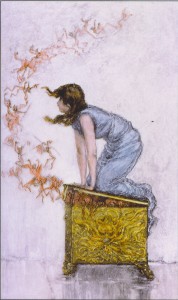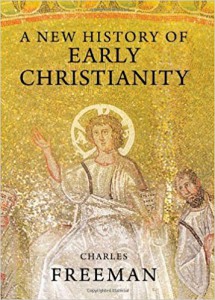[First posted 2012. Our former long-time bible teacher “RW” might say that reading the history of Christianity is the Sinaite’s “Pandora’s Box” . . . . For those unfamiliar with this Greek myth, here’s WIKIPEDIA’s short summary:
“Pandora’s box is an artifact in Greek mythology, taken from the myth of Pandora‘s creation in Hesiod‘s Works and Days.[1] The “box” was actually a large jar (πίθος pithos)[2] given to Pandora (Πανδώρα, “all-gifted, all-giving“),[3] which contained all the evils of the world. Pandora opened the jar and all the evils flew out, leaving only “Hope” inside once she had closed it again. Today the phrase “to open Pandora’s box” means to perform an action that may seem small or innocent, but that turns out to have severely detrimental and far-reaching negative consequences.
If you’re thinking like ‘RW’, you might say that this Greek myth has a striking similarity to Genesis 3: Eve’s curiosity and resulting violation of the Creator’s prohibition not to eat of the fruit from the Tree of the Knowledge of Good and Evil. Please check out this link:
Actually, the Sinaite’s “Pandora’s Box” might be the wrong image to use since it creates a negative impression: in this Greek myth, all kinds of “evil” are unleashed when the box is opened. In our case, it is just the opposite: by reading the history of Christianity, we discovered historical facts that eventually made us decide to further investigate the roots and beginnings of the religion we were in for decades of our life, since our childhood. The result? We left our religion and sought out its claimed ‘foundations’ in the Hebrew Scriptures. Now you, reader, decide: is the search for Truth evil? Is ignorance ‘bliss’? So what is the connection to this post? Well, it’s one of the books we are featuring about the history of Christianity. Would that result in “evil”? Or “Truth”? And is Truth “evil”? You decide.—Admin1.]
—————-
Reprinted below as an “appetizer” is the PREFACE:
In AD 30, a Jewish Preacher from Galilee called Jesus arrived in Jerusalem for the Passover. A crowd of his followers had come with him and the bustle and excitement soon spread to the Jerusalem crowds. Jesus had talked of ‘a coming kingdom’, a spiritual and political revolution that would renew Israel. The authorities, the Jewish priesthood and their Roman overlords, felt threatened by the disturbance. They arrested and crucified Jesus, the best way of publicly terrorizing his followers. It appeared they had snuffed out the movement.
Somehow, in the bleak hours and days that followed, a core of Jesus’ followers began to conceive of him as something more than an ordinary mortal. There was talk that his tomb had been found empty and that favored disciples had seen him risen from the dead. Then, after forty days at most, the appearances ceased, although some believed he would come again.
As the months and years passed and there was no second coming, his disciples began to speculate on whom Jesus might have been. They had a mass of Jewish titles to draw on — ‘Son of God’, ‘Messiah’, ‘Son of Man’, ‘Lord’, ‘Prophet’. For a Jew none of these implied divinity. ‘Son of God’ meant only one specially favored by God; messiahship was associated with the (inevitably violent) liberation of Israel from foreign domination by one of ‘the royal house of David’. From the earliest days Christians debated and argued among themselves as to how one could find a coherent understanding of Jesus. In his anguished First Letter to the Corinthians, one of the oldest Christian texts to survive, the apostle Paul complained that his readers had divided into followers of himself, of the apostle Peter, of an intellectual, Apollos, and of Jesus now seen as Christos, ‘‘the anointed one’ (1 Corinthians 1:12-14).
This picture of Christians in debate may seem startling to some readers. All too often Christian doctrine is presented as fixed and unchallengeable, but even the slightest contact with the history of Christianity shows that this was never so. This book takes it for granted that there were competing traditions within the emerging church and explores the difficulty in ever finding any one ‘true’ Christianity. In fact, it was only when the Roman emperors of the fourth century used the enormous coercive power and patronage at their command to insist on a uniform set of beliefs that one could talk in such terms.
So while, traditionally, the history of the church has been written as if the doctrines chosen by the emperors, in particular the Nicene formulation of the Trinity, were the only ones possible, I have not made this assumption here. I prefer, for instance, to highlight the impossibility of achieving any form of consensus on the nature of the risen Christ and his relationship to God. I hope this makes for an altogether more absorbing narrative and one that corresponds to the debates as they are recorded.
At the same time, assertions by biblical scholars that there are no other historical explanations of particular events than supernatural ones need to be challenged. The sources which describe the physical resurrection of Jesus are, for instance, so late, fragmentary and contradictory that the question of whether it happened must be left open. ‘Surely, no one would seriously argue that the early Christians did not believe that Christ had been raised’, writes Alan Segal, author of an excellent study of ‘the Afterlife’. ‘But just as surely few if any modern historians would argue that any evidence could move us from this historical fact to the supposition that Jesus was actually and physically raised from the dead and that he appeared in his transformed fleshly body.’
This raises a vital point. Historians and theologians are both committed to finding ‘truth’, yet both work with totally inadequate evidence. For the historian the past recedes quickly and most events are never recorded. Most historical solutions exist as hypotheses, vulnerable to the discovery of new evidence or to be left for ever unproved. The theologian has the challenge of establishing knowledge of a different sort: what might exist for humans after death, whether a creator designed the world and whether Jesus Christ had a human or divine nature, or some form of combination of them. On the whole, theologians appear to find it easier to come to certain conclusions than historians do. It is rare, for instance, to find a work of theology that proposes a range of hypotheses about the supernatural and leaves it open for the reader to decide.
This was certainly not the case in the early church. One of the fascinations of writing about these centuries is to see how highly educated minds grappled with the problems of understanding the supernatural. The range of debate is far greater than anything one finds in discussions on religion today. Was Jesus’ God the same as the Creator God of the Old Testament? Can Paul be read so as to deny the physical resurrection of the body? Did the act of creation involve bringing order to what already existed or was it a totally new beginning? Can one ever come up with a satisfactory definition of the relationship with the Son and the Father and the human and divine (if any) aspects of Jesus? This was the grist of early Christian theology.
So a historian of early Christianity must tackle diversity, and I think it helps if one does not feel that there is a correct answer to be found. Intellectual, not to say spiritual, life lost a great deal when theological debate was suppressed in the fourth and fifth centuries. I have tried to preserve the breadth of early Christian thought without making judgment on it.
The world was transformed by the coming of Christianity. The belief that the Son of God had come to earth, had redeemed the human race from its apparent sinfulness, and would be represented by the continuing presence of the Holy Spirit was revolutionary. It was also, of course, very threatening. The rejection of the ancient gods and the cultures that had sustained them was a powerful challenge to the ethos of Greco-Roman society. In response to opposition, Christians had to define for themselves what their faith meant for them while they were living on earth and how their beliefs could be given continuity and coherence.
The ‘triumph’ of Christianity in the fourth century, when Constantine offered both toleration and patronage, was seen by its historian Eusebius as the inevitable and expected outcome of God’s plan. Christianity had now become politically, socially and, not least, economically the dominant culture of the empire and its successors.
Resources were poured into buildings, bishops became powerful figures in their own right. The state took responsibility for defining orthodoxy. The afterlife, and whether one would find bliss or misery in it, began to pervade the Christian imagination in a way that pagans found incomprehensible. No one can begin to understand the history of the western world without grasping this transformation in consciousness.
There has long been a need for a ‘new’ history of Christianity. In a review of yet another set of essays in a handbook to early Christian studies, one biblical scholar recently bemoaned the fact that there had been no such introduction since Henry Chadwick’s excellent The Early Church, first published in 1960s. Yet I would never have taken on this book if I had not been challenged to do so by Heather McCallum, my editor at Yale. It was her vision of the book as a critical but respectful history, and her continued support during the two years of writing it, that have been fundamental to its completion.
Table of Contents include the following topics:
PART ONE: BEGINNINGS
Chapter 1: A Trial
Chapter 2: The Seedbed: Judaism in the First Century AD
Chapter 3: Jesus before the Gospels
Chapter 4: Breaking Away: The First Christianities
Chapter 5: What Did Paul Achieve?
Chapter 6: The Letter to the Hebrews
Chapter 7: Fifty Years On: the Gospel Writers Reflect on Jesus
Chapter 8: John and the Jerusalem Christians
Chapter 9: Creating a New Testament
Chapter 10: No Second Coming: The Search for Stability
PART TWO: BECOMING CHRISTIAN
Chapter 11: Toeholds in a Wider Empire
Chapter 12: Open Borders: The Overlapping Worlds of Christians and Jews
Chapter 13: Was there a Gnostic Challenge?
Chapter 14: The Idea of a Church
Chapter 15: To Compromise or Reject: Confronting the Material World
Chapter 16: Celsus Confronts the Christians
Chapter 17: The Challenge of Greek Philosophy
Chapter 18: Origen and Early Christian Scholarship
Chapter 19: New Beginnings: The Emergence of a Latin Christianity
Chapter 20: Victims or Volunteers: Christian Martyrs
Chapter 21: The Spread of Christian Communities
PART THREE: THE IMPERIAL CHURCH
Chapter 22: The Motives of Constantine
Chapter 23: Debating the Nature of God
Chapter 24: The Stifling of Christian Diversity
Chapter 25: The Assault on Paganism
Chapter 26: ‘No one is honored before him’: The Rise of the Bishop
Chapter 27: An Obsession with the Flesh
Chapter 28: The End of Optimism: Augustine and the Consequences of Sin
Chapter 29: Divine but Human
Chapter 30: The Closing of the Schools
Chapter 31: A Fragile Church: Christianity and the Collapse of the Western Empire
Chapter 32: Faith, Certainty and the Unknown God
This book is downloadable on a kindle app as an ebook at amazon.com.


